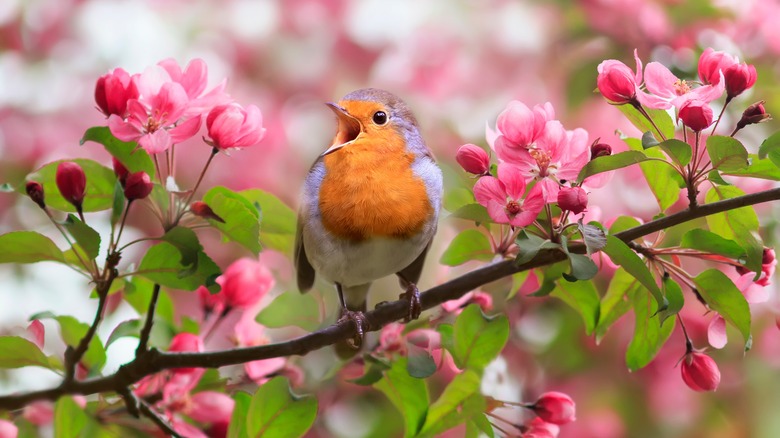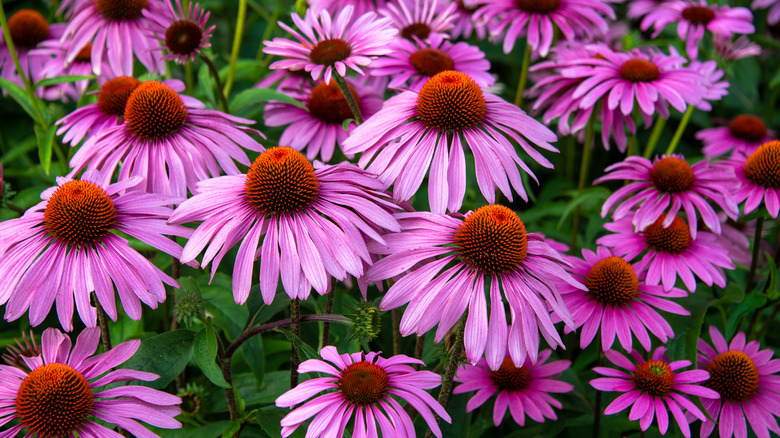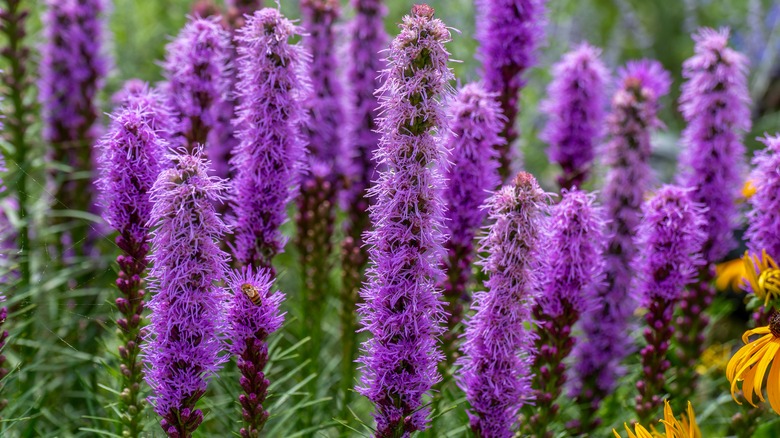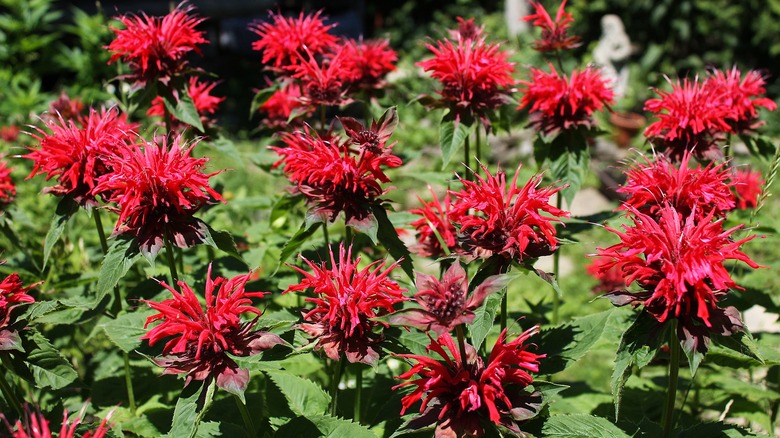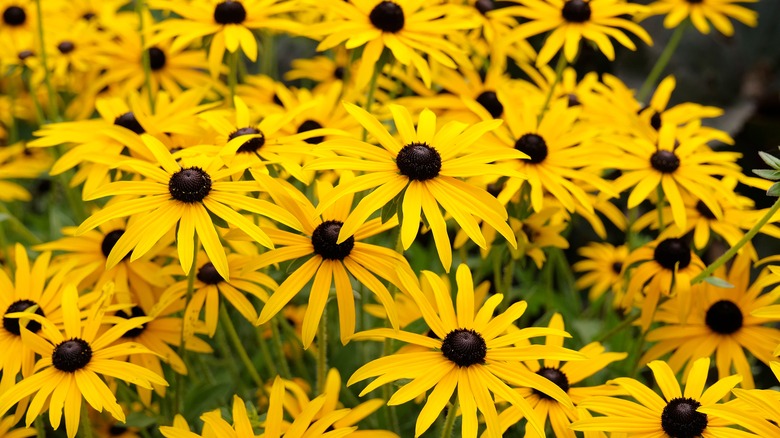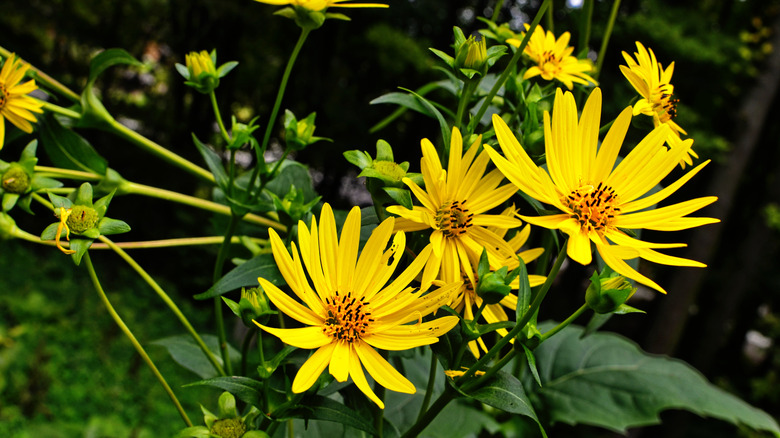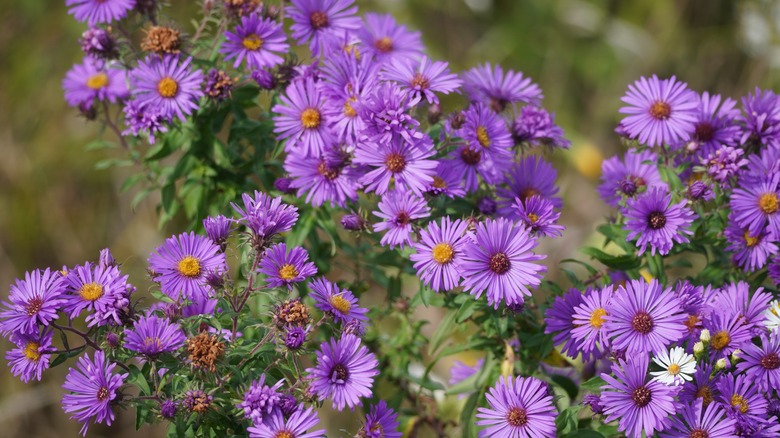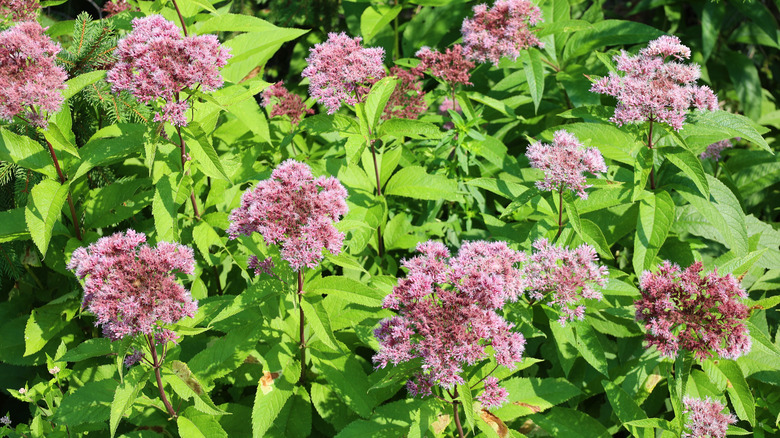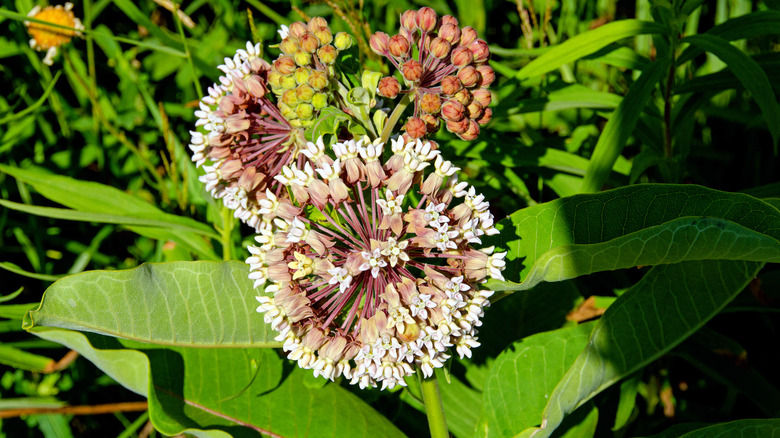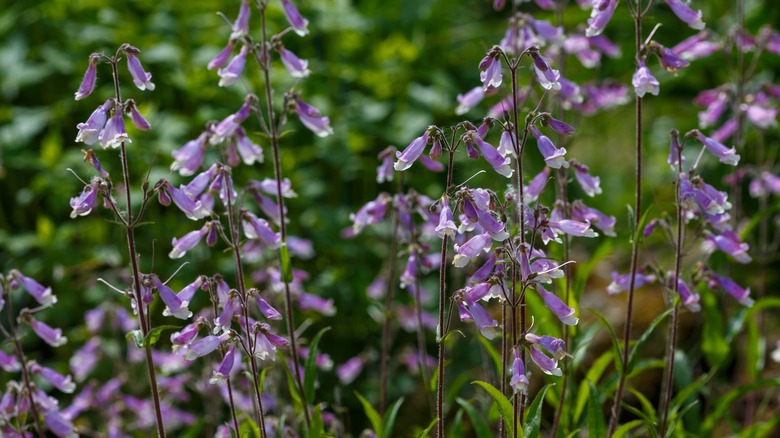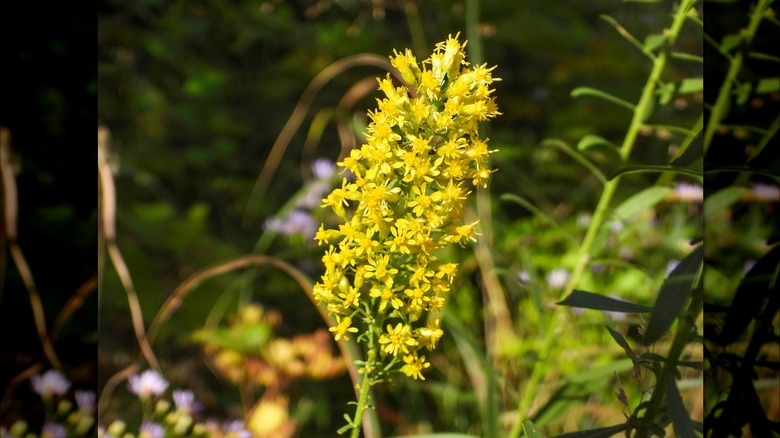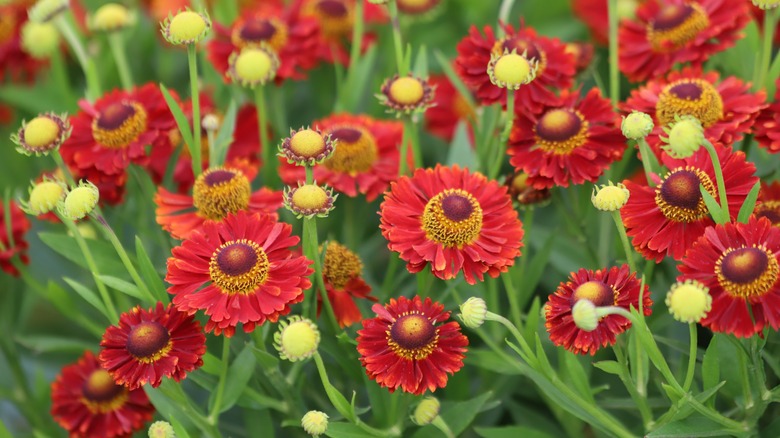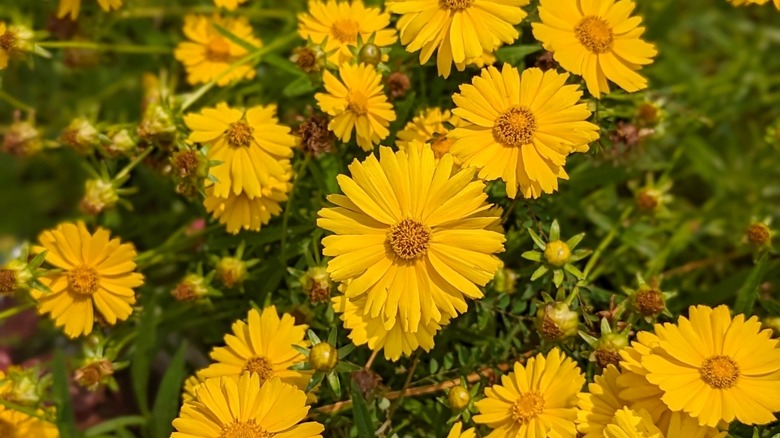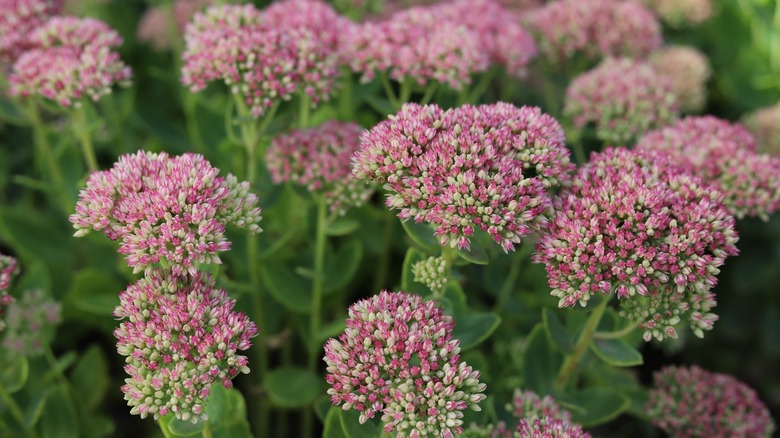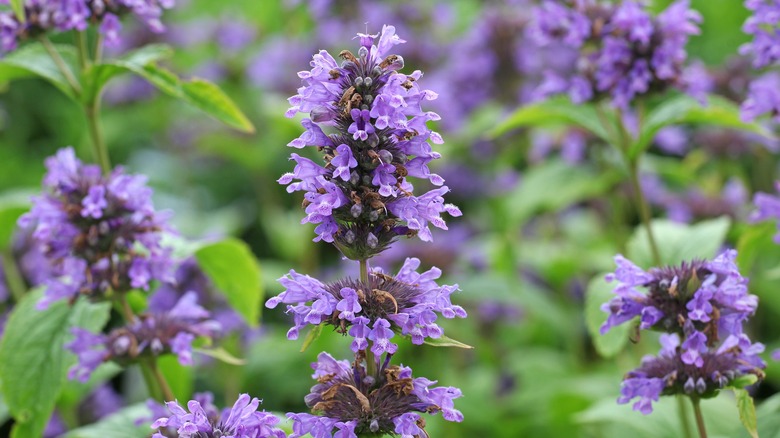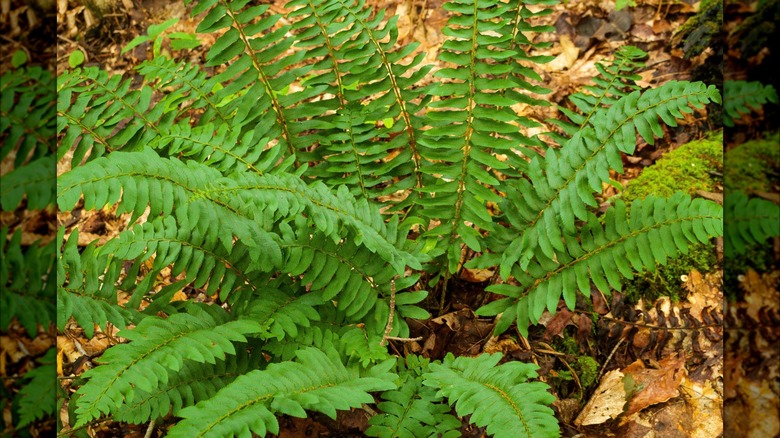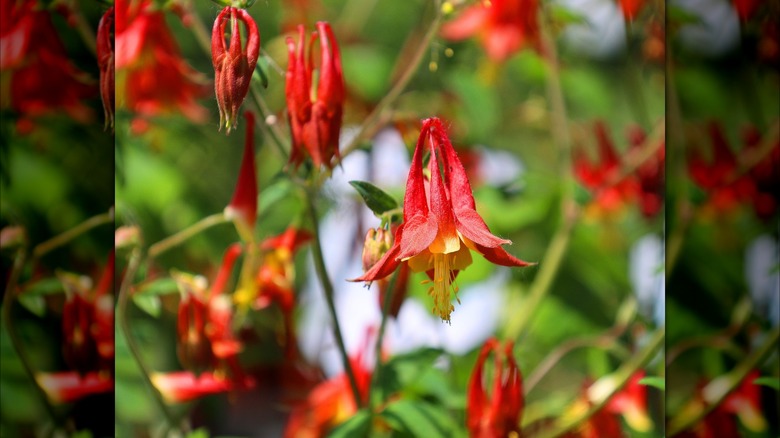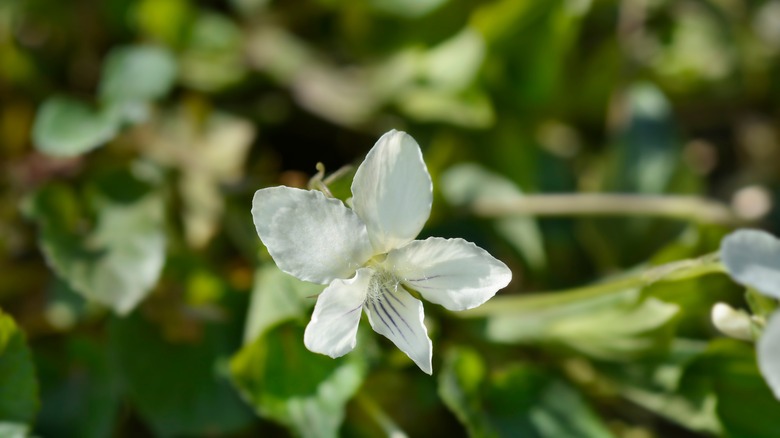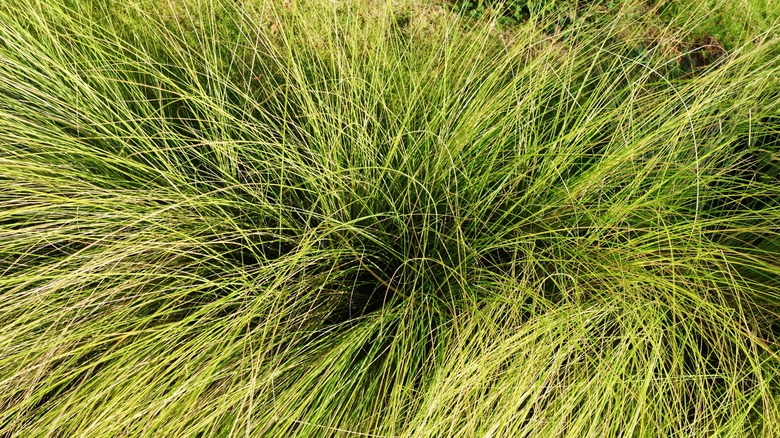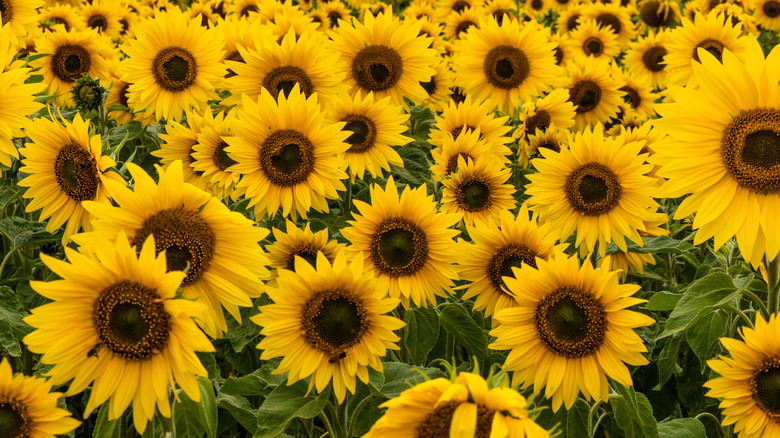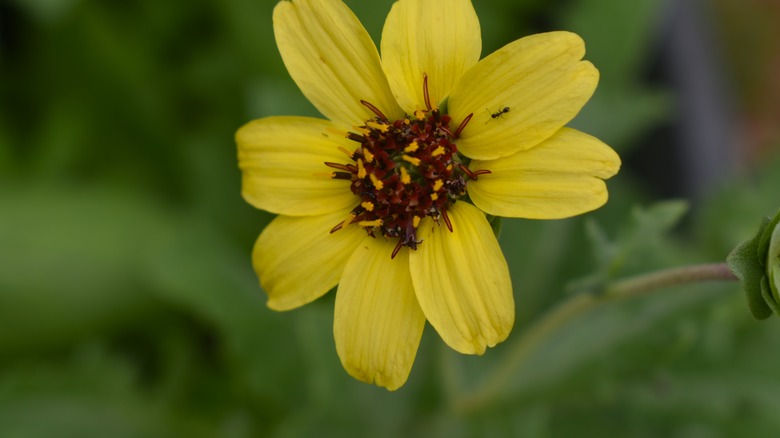20 Perennial Plants To Add To Your Yard To Attract Birds Year-Round
Whether you're embarking on the noble venture to reverse the declining bird population or preparing to revitalize your yard with bird song, you'll usually be inspired to take the same action: put out a bird feeder. But as your love for birdwatching deepens (and the commensurate poor economics of the birding industry takes a toll), you'll want to rethink your gardening choices. Moving away from plain old ornamentals to plants that are attractive to birds is one such action. Plus, if they happen to be perennials? Even better — both for birds and your pockets, as they'll both return happily year after year!
However, the key to turning your yard and garden into a bird haven isn't as straightforward. Perennial plants represent only a layer; they must be supplemented with water, perching, and roosting sources. Most of all, your lot of perennial plantings should be highly diverse to provide a little something for the varied birds visiting your yard. For instance, insect-hosting common milkweed satisfies insectivorous birds, while sunflowers keep other backyard visitors assuaged. Similarly, perennials like the Christmas fern persist through the winter, providing necessary cover when other plants have grown dormant. So, be conscious of what you plant, refrain from deadheading the seed producers early, and allow their leaf litter to enjoy some limelight in the fall to help the foraging birds out. With that in mind, read about the perennial plants you can add to your garden to attract birds.
1. Purple coneflower
Hailing from the eastern and central US parts, purple coneflower (Echinacea purpurea) is a stunning plant that'll have birds and butterflies flocking to your yard. Summer round, coneflowers produce gorgeous, bee-calling, lavender, pink, or burgundy ray flowers that make way for black, conical fruits and seeds, devoured in full by goldfinches, towhees, chickadees, and other songbirds through the winter. Grow coneflowers in drifts for deer deterrence or pair with black-eyed Susans in sunny sites for an idyllic bird haven. Separate them every four years and watch for common pests that are after your coneflower, especially Japanese beetles.
2. Prairie blazing star
Prairie blazing stars (Liatris pycnostachya) are one of the best native plants to grow if you live in the Mountain West region to attract a litany of pollinators. Hummingbirds (and gardeners) fall hard for their summer through fall-blooming violet (occasionally, white) fuzzy flower heads, which eventually dry down to set seeds, aka songbirds' fall snacks. As the perennial plants grow over 4 feet tall, they should be staked and grouped at the back of mixed borders. Tolerant of most soils, including clay and sand, prairie blazing stars bloom copiously in moist, acidic, and nutrient-poor sun-bathed mediums.
3. Bee balm
Comprising over 16 species native to different US parts, bee balm (Monarda) is a pollinator magnet with a punctuated effect on ruby-throated hummers and birds who like its nectar and seeds. Gardeners appreciate their raspberry pink or lavender tubular flowers that can be deadheaded to extend the summer blooming season and prevent bee balm from taking over your garden. However, as monardas are highly susceptible to powdery mildew, ensure they aren't sitting in the shade, overfull beds, or parched during droughts. Otherwise, the fungal disease will metastasize. Also, consider planting the more resistant varieties, like 'Violet Queen.'
4. Black-eyed Susan
Ditch the hassle of juggling multiple seed mixes and attract birds by making your own birdseed (or rather making them harvest their own) by growing black-eyed Susan (Rudbeckia hirta) in your garden. As if taking over the baton (or showing gratitude) from the brown-eyed flowers to maintain the yellow spectrum, American goldfinches dive down to the dried pods in late summer for a quick nibble. Nuthatches, cardinals, and chickadees are just as enamored. Avoid growing black-eyed Susans near turfgrass, as nitrogen-heavy fertilizer drift can reduce plant vigor. Grow the eastern US natives in full sun.
5. Common cup-plant
Despite the affix "common," cup-plant (Silphium perfoliatum) pulls uncommon stunts by banding together its leaves around the stem in a way that allows it to hold on to (a shallow cup of) water, catching the fancy of goldfinches. Hummingbirds are attracted to its disked flowers' golden halo while songbirds wait their turn for the seeds. However, deadhead some blooms, or the prolific self-seeder may overrun your garden beds. However, this may be a non-issue for those trying to naturalize clay or wet sites. The 8-foot tall, southeastern US native wildflower is unwelcome in Connecticut.
6. New England asters
Renowned hosts of scores of butterflies, including monarchs, New England asters (Symphyotrichum novae-angliae) are just as effective as bird sirens. In early summer, these nearly 7-foot-tall perennials provide cover to mothering birds and their babies. After delighting their growers with the yellow-throated, purple flowers, they mature into seeds that cardinals and nuthatches consume well into the winter. Deer-resistant, these beautiful plants will thrive in clay soil, provided it's chockful of organic content. Pinch the tops to induce bushier growth, evading stake support. Avoid overcrowding the ornamental beds to minimize complications from foliar diseases, including aster wilt.
7. Sweet joe-pye weed
If you're looking to add vertical interest and texture to your yard, sweet joe-pye weed (Eutrochium purpureum), with its over 5-foot build and domed mauve inflorescence, is up to the task. Not only does it attract bees and butterflies from late summer to early fall, but it also ropes in birds to pollinate by enticing them with seeds throughout the winter. Unless you wish to indulge in seed roulette (considering the poor germination rate), use stem cuttings to grow joe-pye weeds. Provide at least six hours of sunlight to prevent the plants from toppling over.
8. Common milkweed
When you're willing to naturalize it or plop pots in your central US-based yard, common milkweed (Asclepias syriaca) is the go-to native perennial to attract birds. Led by their noses, bees, butterflies, and beetles dot milkweed's pale pink or lilac umbels simultaneously while the hummingbirds haggle for the nectar. Allowing some flowers to set seeds into the fall presents a ready buffet for the songbirds, although they'll help themselves anyway to the miscellaneous 450 insects jawing away at the milkweed. Fret not. They won't go after the monarchs, as they assume they've loaded up on toxic cardiac glycosides.
9. Bearded tongue
Easing the spring-to-summer transition with its flashy multi-hued tubular flowers, bearded tongue (Penstemon) is sure to catch the fancy of hummingbirds, along with native plant enthusiasts searching for varieties local to their area and growth conditions. Other pollinators, including bumble and mason bees, are just as charmed, especially if penstemons are colored white or blue. Songbirds enjoy the mature seed pods left on the plant by summer's end. To enjoy the best performance, expose penstemons to at least six hours of direct sunlight and ensure the dirt filters well to discourage root rot. Maintain neatness through regular division.
10. Showy goldenrod
When coupled with asters, showy goldenrods (Solidago speciosa) lend a gorgeous fall color and form contrast to the garden with their pyramidal, yellow flower stalks while amplifying the pollinator bonanza. After you're done inducing reblooms through deadheading, allow the last batch to grow seed pods, as they're coveted by songbirds. Luckily, they aren't as adamant about re-seeding as their other goldenrod cousins, making their sprawl easier to handle — more so if the birds have done a good job. Give the 4-foot-tall herbaceous perennials full sun and securely pop them in clay soils. Separate clumps every couple of years.
11. Sneezeweed
To populate the area surrounding the garden pond or to flood your rain garden with abundance, grow sneezeweed (Helenium autumnale), a perennial soggy soil lover. Naturally found in most US regions, sneezeweeds are quite showy in rich substrates showered in bounteous sun, although you're better off planting their cultivars that aren't as weedy, assume more saturated tones, and extend their summer-blooming season right up to frost. Sneezeweeds are a handful at blocking deer and rabbits but can harm humans, pets, and livestock if consumed. Plunk them behind seed-producing bee balms, coneflowers, or goldenrods to offer birds seed diversity.
12. Star tickseeds
From grosbeaks and cardinals to finches and buntings, you'll be hard-pressed to find a big-beaked bird that doesn't perch on low-growing star tickseeds (Coreopsis pubescens) to gobble up their insect-resembling seeds. Endemic around the rockier southeastern US states, tickseeds' ability to withstand drought and heat pressure makes them suitable for planting when you have no shade in your yard. Remove the faded, orange-disked yellow blooms regularly to keep the butterflies coming for the successive flushes, but quit the practice when the weather starts to cool to encourage seeding. Favor shorter cultivars in light of their diminished spreading propensities.
13. Sedums
You might be privy to sedum or stonecrop's (Sedum spp.) role as the perfect ground cover for year-round color in your garden, but not to their bird magnetism. Siskins, chickadees, and grosbeaks adore their seeds that arrive after their chartreuse, white, or orange flowers have had a blast from spring through fall. Interestingly, these birds are also attracted to the foliage, especially when it collects water from a rain spell, although not many will appreciate the subsequent chewed-through damage. Mass plant sedums in sunny or moderately shaded spots, regardless of the texture and drainage, considering their high adaptability.
14. Anise hyssop
Anise Hyssop (Agastache spp.) is a perennial plant that will fill your garden with hummingbirds and butterflies who enjoy its bluish-purple, two-lipped flowers. Deadheading will extend their blooming season late into the fall while topping your potpourri mixes concurrently. However, your yard will break into a song only after the birds, including goldfinches, have put their beaks to the yummy seeds. Hyssops appreciate full sun but will tolerate partial or dappled shading. Poor drainage is a deal breaker, as it makes them vulnerable to powdery mildew and rust. Avoid these US natives if rabbits are a nuisance.
15. Christmas fern
No flowers, no seeds, yet well-liked by songbirds? That's Christmas fern (Polystichum acrostichoides) for you! Growing sword-shaped, leathery soft fronds (leaves) like a fountain, Christmas ferns are a decent groundcover if shade, deer, rabbits, or squirrels have been spewing any trouble. No amount of snow flurries can destroy their evergreen beauty, and ground-dwelling birds know that, huddling together in the mound or weaving its shed parts into their roosting nests. Around late spring, the perennials develop black spores on their undersides, indicating new growth. Grow them in moist soils for the best fronds, and avoid pruning unless necessary.
16. Eastern columbine
With red tubular flowers hanging down like eagle talons, it's a surprise eastern columbines (Aquilegia canadensis) attract birds, like both ruby-throated hummers and songbirds. Indigenous to the North American continent, columbine plants ideally work as ground covers since they usually stay under 3 feet. Best of all, they don't hunger after sunlight and accomplish a better form in partially shaded, damp yards. However, being self-seeders, eastern columbines can encroach into unwanted territories, except when the soil is acidic. Shear the foliage in peak summer to get a hold of powdery mildew. Geese may trouble juvenile plants.
17. Pale violet
Another groundcover contender with bird-attracting attributes is pale violet (Viola striata), a perennial wildflower native to the east US. It adds a white (occasionally purple) touch to the spring and summer garden with its tubular flowers, for which miner bees and butterflies are particularly grateful. Birds join in on the fun when the copper fruits are out in full glory, with ants jostling with them (and winning) from the split seeds, contributing to some intrusive spreading. Viola flowers prefer alkaline, humusy soils and tolerate wet sites. They may also work as understories, given their love for modest shade.
18. Pennsylvania sedge
Popular amongst central US-based turf owners meaning to switch over to sustainable and native grass-like plants, Pennsylvania sedge (Carex pensylvanica) is equally attractive from the birds' and pollinators' point of view. That's because their slender blades — as is common to all sedges — provide splendid nesting habitat or quick cover when the songbirds are on and about their business throughout the year, unless winter-killed. Pennsylvania sedge is a sucker for shade and moist soils but tolerates sandy texture and moderate foot traffic. Pair it with early spring bulbs or oak trees to create a splendid bird haven.
19. Sunflower
Plenty of sunflower (Helianthus) varieties, including ten-petal (Helianthus decapetalus), narrow leaf (Helianthus angustifolius), and other hybrid cultivars ('Suncatcher') are perennials (rather than annuals) that enjoy massive attention from birds. This is, of course, possible only if the overripe flower stalks remain standing throughout the winter to empower the songsters to pick off the seeds at their convenience. Although perennial sunflower seeds are relatively smaller, they make up for their size through abundant production. Just look for varieties native to your area with hopefully diminished spreading tendencies and plant them wherever the sun is plentiful.
20. Chocolate daisy
Chocolate lovers can have both their homes and gardens smelling like sweet cacao by establishing chocolate daisy (Berlandiera lyrate) plants smack dab in the alkaline soils. These chocolate flowers — which also go by the moniker 'green-eyes,' as their yellow petals drop down, leaving green disks in their stead — pique songbirds' interest with their cup-shaped, seeded fruits that appear year-round. Their deflowered, deer-resistant, velvety silver foliage is just as spectacular, making them strong runners in their native southwestern US ranges. Offer the daisy plants good drainage, or else they'll rot.
